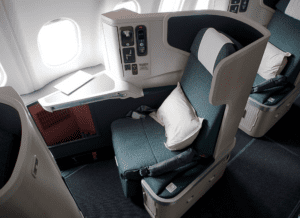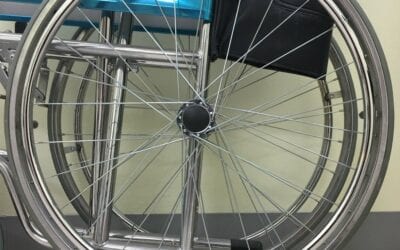Expecting to get an upgrade to First Class when you dress up is generally a myth. You need elite status in the airlines’ frequent flier programs.
 For years I’ve heard the advice attributed to flight attendants about what to wear to get free upgrades when flying. Most don’t work. All passengers should dress up for their comfort, health, and safety.
For years I’ve heard the advice attributed to flight attendants about what to wear to get free upgrades when flying. Most don’t work. All passengers should dress up for their comfort, health, and safety.
Too often, women, for example, are told to avoid jeans or trainers and instead wear tight black trousers and a blazer or dress. In my opinion, that’s not only bad advice, but getting an upgrade by dressing well is generally a myth.
Unpurchased first-class seats go to passengers with elite status in airline frequent flier programs. What people wear doesn’t matter.
In addition to dressing for comfort, health, and safety, air travelers should dress to help smooth their way through TSA airport security checkpoints.
That said, dressing right to fly is essential, but not to obtain an upgrade. Dressing right is important to fly comfortably, healthily, and safely, even in an emergency. Air travelers should also dress appropriately for getting through TSA (Transportation Security Administration) security checkpoints with as little hassle as possible.
Decades ago, dressing up might have gotten you a first-class upgrade. Today, the airlines have an upgrade hierarchy that doesn’t include how air travelers dress. Frequent airline fliers fill first and business-class seats that go unpurchased with elite status. The higher the status, the earlier the assignment, often well before the day of departure. At American Airlines, for example, members with Executive Platinum Status are assigned upgrades up to four days before their flights. Generally, unpurchased first or business-class seats are fully assigned to frequent fliers with elite status by the night before departure. On my last trip to Los Angeles, I was upgraded three days before each flight.
It doesn’t happen often, but it’s possible — if there is an empty first class seat — to get an upgrade via a gate agent, but it won’t be free.

Wearing tight clothing on airplanes is a mistake for anyone and can exacerbate problems for some passengers prone to deep vein thrombosis.
The suggestion to wear tight clothing to dress up is poor. Think of comfort if you are stuck in an airplane cabin for an hour or more. Moreover, according to how tight your clothes are, it could become a serious problem. Clothing that’s tight enough, along with the conditions in airplane cabins, can lead to some passengers developing blood clots while in flight. It’s called deep vein thrombosis (DVT).
For some passengers, such as seniors, those with varicose veins, and those who are overweight, flying can be potentially problematic. Blood clots can sometimes form in our legs during air travel because we are immobile for long periods. Passengers, particularly those in the economy class who generally sit in cramped spaces with little legroom, are most at risk. Aside from being uncomfortable, tight and binding clothing can impair blood circulation in the legs, further promoting blood clots.
Tight, as well as loose or elaborate clothing, plus clothing with a message, should be avoided when flying.
Here is my list of what not to wear when flying.
Tight clothing:
DVT can be a serious potential problem for older travelers and travelers with various conditions. These travelers, and travelers in general, should avoid tight clothing. It can bring on DVT, but why should anyone be uncomfortable flying just to be chic? You can be stylish without being uncomfortable, if that’s important to you.
Loose or elaborate clothing, dresses or shorts:
In case of an accident, loose or elaborate clothing and wide-legged pants can get snagged on obstacles in a plane’s tight quarters if there’s interior damage. In an evacuation, dresses and shorts offer little protection in the cabin and none from friction burns from evacuation slides. Additionally, dresses and shorts won’t keep you warm when the temperature drops in airplane cabins, especially on longer flights. Some dresses and shorts might be considered too short under airline dress codes.
Revealing clothing or clothing with offensive or political messages:
The airlines have dress codes. Some are strict and enforced. There is no point in being refused to board or humiliated by gate agents or flight crew. Is making a “statement” worth it if you miss your cruise, connecting flight, or event?
High heels, open-toed shoes, flip-flops, and sandals:
None of these shoes make any sense in case of an aircraft accident. Each will put you at risk of having your feet cut and make it harder to evacuate.
Clothing that needs a belt to hold it up could be a real problem in the full-body scanner at TSA
Clothing that needs a belt:
Most air travelers need to remove their belts when going through airport security. Don’t wear clothing requiring you to hold it up without a belt.
Clothes made from synthetics or high synthetic content blends:
In case of an airplane accident, synthetic fiber-based clothing fabrics can melt on your skin in a fire, causing serious and even fatal wounds. Avoid wearing those fabrics on your flights.
Here is my list of what to wear when flying.
Smart air travelers wear layers, natural fiber fabrics that breathe that are comfortable, and comfortable slip-on shoes.
Layers:
By wearing layers of clothing, it’s easy to adjust how much you wear according to the temperature of the cabin on your flight, which tends to vary a great deal.
Natural fibers:
Wear clothing made predominantly with natural fibers to protect you in case of an accident. They won’t melt into your body and will protect you better than synthetic fibers.
Breathable fabrics:
Fabrics that allow air to circulate through them won’t trap perspiration on your body, making you feel dirty and uncomfortable. They’ll also help prevent odors from your body and clothing.

Wearing comfortable clothing, including undergarments, help make any flight, especially long flights, easier to handle in the cramped conditions of airplane cabins.
Comfortable, slip-on shoes:
Like comfortable garments, comfortable shoes are a must to endure long or short airplane flights. Slip-on shoes help you get your shoes off, then back on, without trouble at TSA security checkpoints.
Compression socks:
Many doctors recommend compression socks for seniors and pregnant women. They promote blood circulation and prevent leg swelling, guarding against DVT.
A jacket or travel vest with many pockets can be invaluable as a comfortable third carry-on.
Jackets and travel vests with lots of pockets:
Jackets and travel vests with many pockets can be invaluable as a third carry-on if your carry-on and personal item are overweight or don’t have enough room for your belongings. If you use them, make sure you have something else to wear to layer in case it is cold in the airplane cabin, and your pockets are full in the vest or jacket.
I wear long pants and a long-sleeved shirt made with natural fibers when flying. I typically have a sweater or a jacket and a photographer’s vest with many pockets. Also, I wear slip-on leather shoes for my flights. They will keep me comfortable throughout my air journey and help in case of problems. Don’t forget to have extra clothes in your carry-on in case of an in-flight accident, such as a hot or cold beverage being spilled on you. It’s happened to me.
READ ALSO:
What the sharp increase in airline complaints teaches us about flying
Can travelers avoid unjust rental car damage charges?
After many years working in corporate America as a chemical engineer, executive and eventually CFO of a multinational manufacturer, Ned founded a tech consulting company and later restarted NSL Photography, his photography business. Before entering the corporate world, Ned worked as a Public Health Engineer for the Philadelphia Department of Public Health. As a well known corporate, travel and wildlife photographer, Ned travels the world writing about travel and photography, as well as running photography workshops, seminars and photowalks. Visit Ned’s Photography Blog and Galleries.



